
Stroke pane controls in Motion
The Stroke pane becomes available when the Brush Type pop-up menu in the Shape Inspector’s Style pane is set to Airbrush or Image. The Stroke pane contains adjustable parameters specific to the paint stroke and brush, such as opacity, width, brush size, and so on.
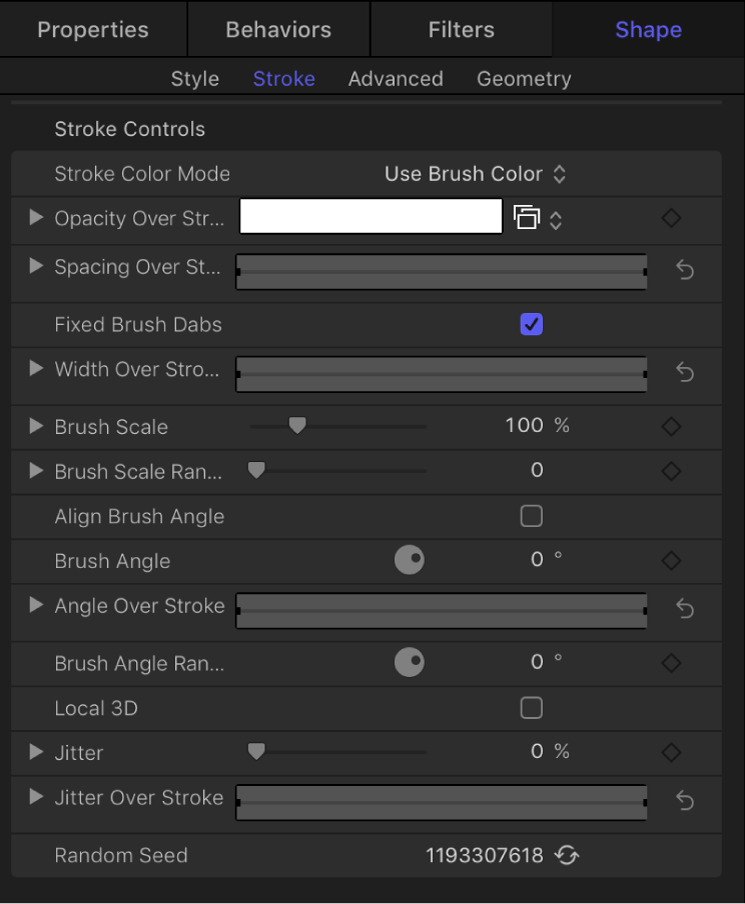
Stroke controls
Stroke Color Mode: A pop-up menu that specifies how color is applied to the stroke over its length. There are three options:
Use Brush Color: Uses the color of the brush as defined by the Brush Color parameter in the Style pane. The stroke is a solid color over its length.
Color Over Stroke: Dabs are tinted based on their position over the length of the paint stroke.
Pick From Color Range: Dabs are tinted at random, with the range of possible colors defined by a gradient editor. A point on the gradient is randomly chosen, so the relative sizes of each color region determine the frequency of the color being used.
Opacity Over Stroke: An opacity gradient editor (available when Stroke Color Mode is set to Use Brush Color) to change the opacity of dabs based on their location on the stroke. This gradient control is limited to grayscale values, which are used to represent varying levels of transparency. White represents solid dabs, progressively darker levels of gray represent decreasing opacity, and black represents complete transparency. A simple white-to-black gradient represents a stroke that is solid at its start, but fades out gradually over its length until finally vanishing at the end. For information on using gradient editors, see Gradient editor controls.
Color Over Stroke: A gradient editor (available when Stroke Color Mode is set to Color Over Stroke) to define the range of color in the stroke, beginning with the leftmost color in the gradient, and progressing through the range of colors until reaching the rightmost color at the end of the stroke. Gradual color changes do not appear in each dab, but only across the stroke as a whole. An opacity bar appears at the top of the gradient editor. For information on using gradient editors, see Gradient editor controls.
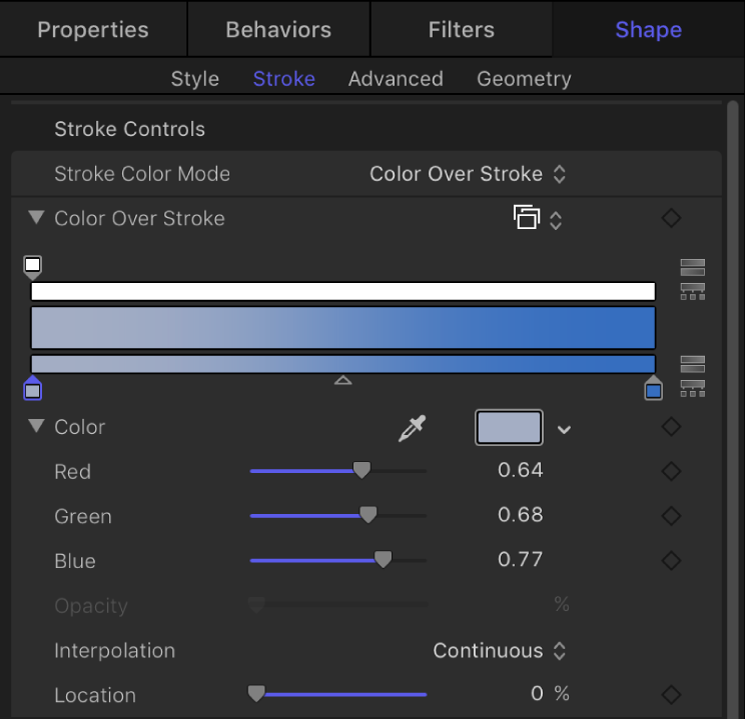
Color Range: A gradient editor (available when Stroke Color Mode is set to Pick From Color Range) to define a range of colors to randomly tint the stroke’s paint dabs. The direction of the gradient colors is not relevant (because this control merely defines the colors to be used in the random tinting). The Color Range parameter has the same controls as the Color Over Stroke parameter. For information on using gradient editors, see Gradient editor controls.
Color Repetitions: A slider (available when the Stroke Color Mode is set to choose Color Over Stroke) that increases the number of times the gradient is repeated over the stroke.
Spacing Over Stroke: A mini-curve editor that lets you customize the spacing of the dabs over the length of the stroke. You can create a curve that gradually increases the dabs’ spacing over the length of the stroke, create a curve that varies the dabs’ spacing over the length of the stroke, and so on.
In the following images, the default Spacing Over Stroke value of 100% in the mini-curve editor creates an even distribution of the dabs—based on the value set in the Spacing parameter in the Style pane. For more information on using the mini-curve editor, see Use the mini-curve editor.
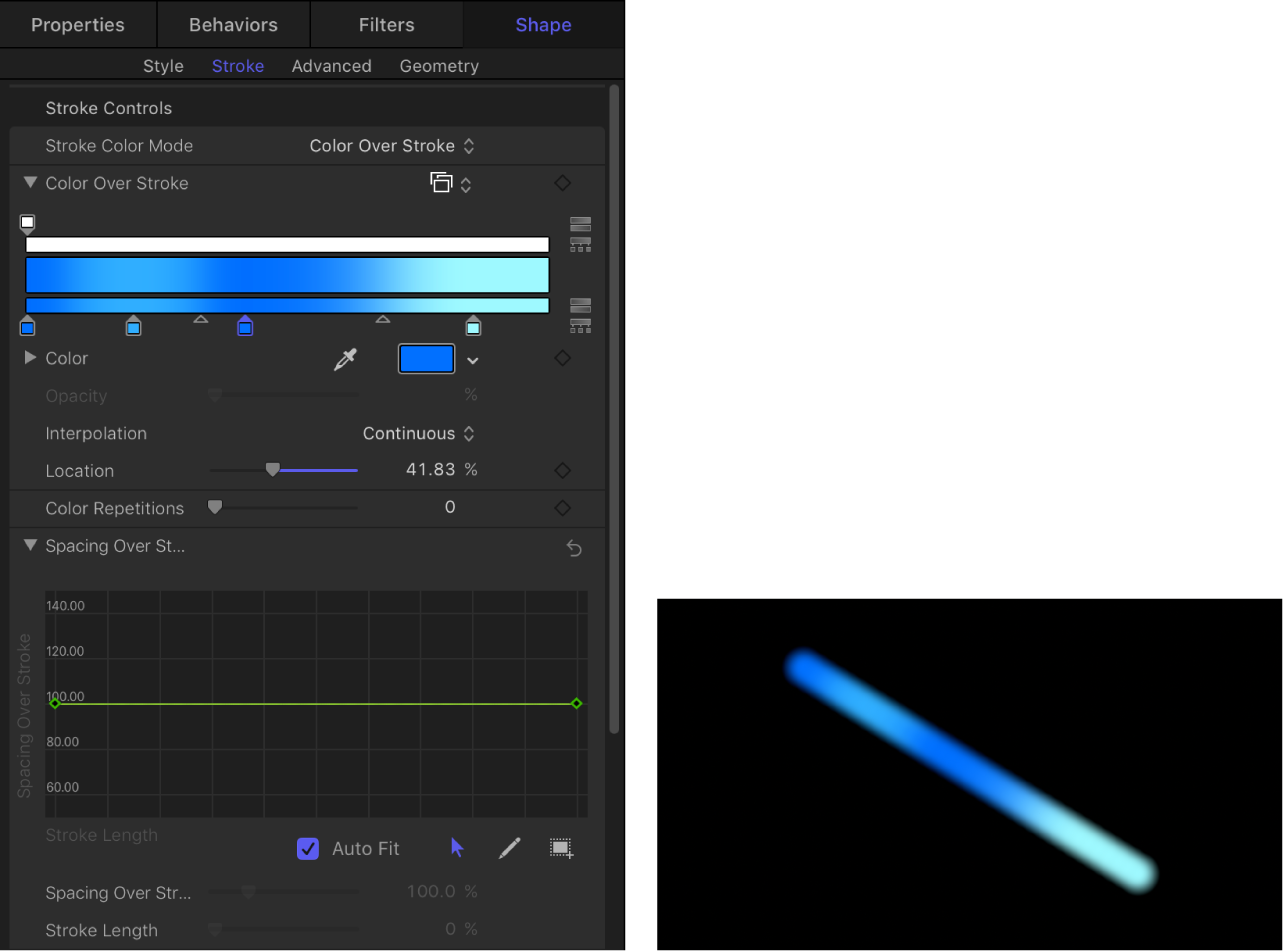
In the following images, the Spacing Over Stroke curve in the mini-curve editor is adjusted to use a greater value at the start of the stroke, and 100% at the end of the stroke. The dabs at the beginning of the stroke are spaced more widely apart and get closer at the end of the stroke.
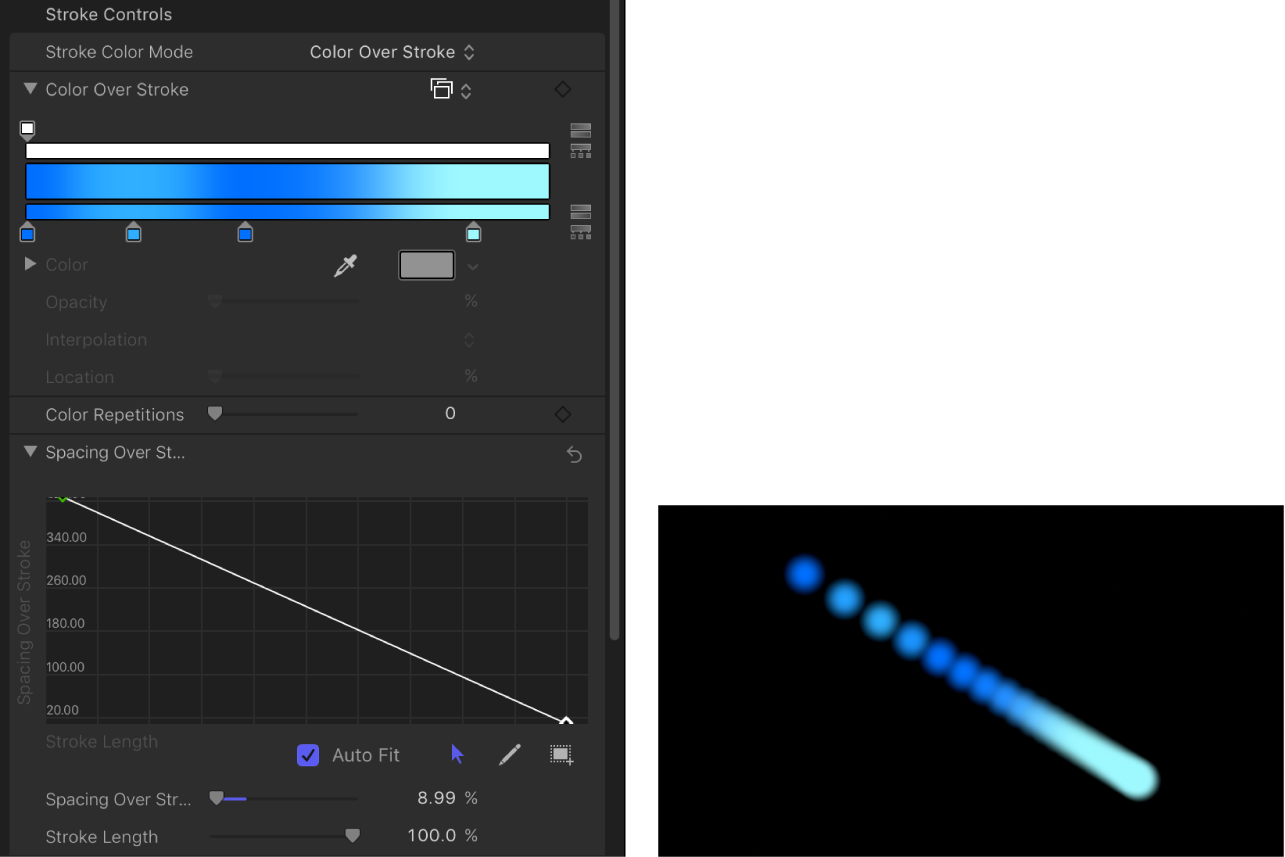
Two additional controls in the mini-curve editor let you fine-tune the values of selected points in the curve:
Spacing Over Stroke: A slider that adjusts the spacing between dabs at the selected keyframe. Increasing this parameter increases the spacing between each dab in the stroke.
Stroke Length: A slider that determines where along the range of the dabs within the stroke the Spacing Over Stroke value (for the selected keyframe) is applied.
Fixed Brush Dabs: A checkbox that, when selected, keeps the number and spacing of the dabs constant regardless of the changes in the stroke’s shape over time caused by behaviors or keyframe animation. The effect of this parameter is not visible when editing a paint stroke on a single frame.
Anchor Dabs To: A pop-up menu (available when the Fixed Brush Dabs checkbox is deselected) that defines how dabs are added to or removed from a paint stroke when the length of the paint stroke is modified. There are two options:
Start: Adds dabs to or removes dabs from the start point of a paint stroke when the length of the paint stroke is modified. The first dab on the stroke remains fixed.
Start and End: Adds dabs to or removes dabs from the start and end points of a paint stroke when the length of the paint stroke is modified. The first and last dabs on the stroke remain fixed.
Note: Changing a shape’s control points or adjusting the Width or Spacing parameters (in the Style pane) or Spacing Over Stroke and Width Over Stroke parameters (in the Stroke pane) affects the dab spacing because larger dabs can be spaced further apart.
Width Over Stroke: A mini-curve editor that lets you customize the width of the dabs over the length of the stroke. You can create a curve that gradually increases the dabs’ width over the length of the stroke, create a curve that varies the dabs’ width over the length of the stroke, and so on. The start value for the dab width is based on the value set in the Width parameter in the Style pane. For more information on using the mini-curve editor, see Use the mini-curve editor.
Two additional controls in the mini-curve editor let you fine-tune the values of selected points in the curve:
Width Over Stroke: A slider that adjusts the width of the dab at the selected keyframe.
Stroke Length: A slider that determines where along the range of the dabs within the stroke the Width Over Stroke value (for the selected keyframe) is applied.
You can also adjust the Width Over Stroke parameter for a selected paint stroke in the canvas. See Adjust stroke width in the Motion canvas.
Brush Scale: A slider that adjusts the size of the brush (the source of the dabs). Click the disclosure triangle to adjust the X and Y scale values independently. By default, Scale is set to 100%—the size of the dabs is equal to the size of the source brush. Unlike the width parameter in the Style pane, brush scale adjustments affect only the size of the dabs and don’t preserve the spacing between dabs.
Brush Scale Randomness: A slider that defines an amount of variance in the scale of the stroke’s brush. A value of 0 results in no variance—all dabs in the stroke are the same size. A value greater than 0 introduces a variance. The scale for an individual dab is defined by the Scale parameter, plus or minus a random value falling within the Brush Scale, Width Over Stroke, and Width (in the Style pane) parameters. Click the disclosure triangle to adjust the X and Y values independently.
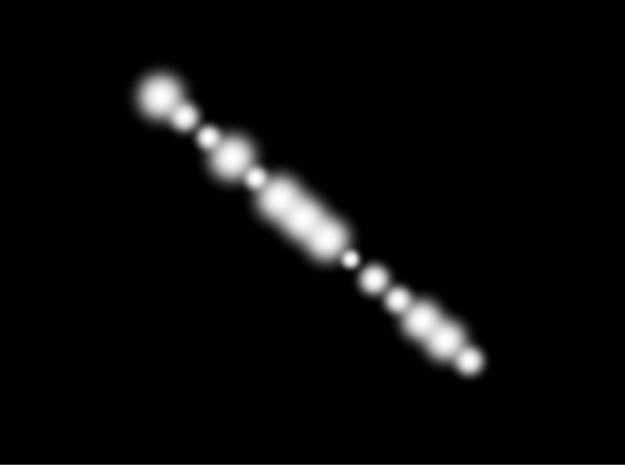
Align Brush Angle: A checkbox that, when selected, causes the stroke dabs to rotate to match the shape on which they are positioned.
Brush Angle: A dial that specifies (in degrees) the rotation of the stroke dabs. Using the default dial or value slider modifies the Z angle. When the Local 3D checkbox (described below) is selected, additional Brush Angle Randomness controls become available. Click the disclosure triangle to expose X, Y, and Z rotation dials and the Animate pop-up menu.
Animate: A pop-up menu (available when the Local 3D checkbox—described below—is selected) that lets you change the interpolation for animated 3D rotation channels. Click the Brush Angle disclosure triangle to display the Animate parameter. There are two menu options:
Use Rotation: Dabs rotate from their start rotation to their final rotation. Depending on the animation, the elements may rotate multiple times before reaching their final orientation (the last keyframed value). For example, if the X, Y, and Z angle parameters are animated from 0 degrees to 180 degrees in a project, the elements rotate on all axes before reaching their final orientation.
Use Orientation: Dabs rotate more smoothly and without multiple rotations. This option interpolates between the dabs’ start orientation (first keyframe) and their end orientation (second keyframe).
Angle Over Stroke: A mini-curve editor that lets you customize the Z rotation (in degrees) of the dabs over the length of the stroke. You can create a curve that gradually increases the dabs’ angle over the length of the stroke, a curve that varies the dabs’ angle over the length of the stroke, and so on. For more information on using the mini-curve editor, see Use the mini-curve editor.
Two additional controls in the mini-curve editor let you fine-tune the values of selected points in the curve:
Angle Over Stroke: A dial that adjusts the angle of the dab at the selected keyframe.
Stroke Length: A slider that determines where along the range of the dabs within the stroke the Angle Over Stroke value (for the selected keyframe) is applied.
Brush Angle Randomness: A dial that defines an amount of variance in the rotation of the stroke dabs. A value of 0 results in no variance—all dabs have the same rotational value. A value greater than 0 introduces a variance. The angle for an individual dab is defined by the Brush Angle and Angle Over Stroke parameters, plus or minus a random value falling within the Brush Angle Randomness. Using the default dial modifies the Z angle. To modify the rotation of the dabs in X, Y, and Z space, or to access the Animate parameter (available when the Local 3D checkbox is selected), click the disclosure triangle.
Animate: A pop-up menu (available when the Local 3D checkbox—described below—is selected) that lets you change the interpolation for animated 3D rotation channels. Click the Brush Angle Randomness disclosure triangle to display the Animate parameter.
Use Rotation: Dabs rotate from their start rotation to their final rotation. Depending on the animation, the elements may rotate multiple times before reaching their final orientation (the last keyframed value). For example, if the X, Y, and Z Angle parameters are animated from 0 degrees to 180 degrees in a project, the elements rotate on all axes before reaching their final orientation.
Use Orientation: Dabs rotate more smoothly and without multiple rotations. This option interpolates between the dabs’ start orientation (first keyframe) and their end orientation (second keyframe).
Local 3D: A checkbox that lets you take advantage of the Motion 3D workspace. When the Local 3D checkbox is selected, the following become possible:
When the Face Camera checkbox (described below) is selected, paint dabs actively face the camera when the camera or stroke is rotated or animated.
When the Dab Depth Ordered checkbox (described below) is deselected, dab ordering remains consistent when the paint stroke (or the camera) is rotated in X or Y space. When this checkbox is selected, the dabs jump in front of each other each time the stroke rotates 180 degrees. In other words, this checkbox draws the dabs in the stroke according to each dab’s actual 3D position in the project. Dabs that are closer to the camera appear closer; dabs that are farther from the camera appear more distant.
When the Dynamics checkbox is selected in the Advanced pane, a paint stroke acts similarly to an emitter—the dabs become particles. When the Local 3D checkbox is selected, the dabs are animated in 3D space. When the Local 3D checkbox is deselected, the particles are animated in X and Y space only. For more information on Dynamics, see Advanced pane controls.
When the Dynamics checkbox is selected in the Advanced pane, some applied Simulation behaviors will pull dabs out of their plane. For example, if a paint stroke has an applied Attracted To behavior (with the Affect Subobjects checkbox selected), and the target layer is in a different location in Z space, the dabs are pulled into Z space and move toward the target layer. The paint stroke must be a member of a 3D group for a behavior to pull dabs out of the X and Y planes. For information about 3D groups, see Create 3D intersection.
Use the following guidelines when working in 3D with paint strokes:
Even in a 2D project, you can adjust a paint stroke’s general properties in 3D space. For example, you can modify the Z parameter (depth) using the Position, Scale, Rotation, and Anchor Point controls in the Properties Inspector.
Paint strokes do not receive reflections (controlled in the Properties Inspector) unless the Local 3D checkbox is deselected.
Paint strokes do not cast shadows (controlled in the Properties Inspector) unless the Local 3D checkbox is deselected.
Lighting does not affect paint strokes unless the Local 3D checkbox is deselected.
Important: Even if the Local 3D checkbox is selected, paint strokes do not intersect with the “global” 3D world. This means that paint strokes can exist in 3D space, but do not intersect with objects that exist inside their own group, or with objects in other groups. A 3D paint stroke is composited with the rest of the objects in the project based on layer order.
Face Camera: A checkbox (available when the Local 3D checkbox is selected) that forces stroke dabs to actively face the camera if the camera is rotated or if the paint stroke is rotated or animated. When the Face Camera checkbox is deselected, the dabs face forward in the stroke and appear flat (unless the source layer or paint dabs are rotated in 3D space).
Because paint source dabs are 2D (flat) objects, dabs are not visible when you use the orthogonal reference camera views, such as Left, Right, and Top (unless the source layer or dabs are rotated in 3D space). This is because orthogonal views are at right angles (perpendicular) to the dabs. For more information on using cameras, see Add a camera.
Dab Depth Ordered: A checkbox (available when the Local 3D checkbox is selected) that keeps paint dab ordering consistent when the paint stroke is rotated in X or Y space. When Dab Depth Ordered is deselected, the dabs jump in front of each other each time the stroke rotates 180 degrees.
Jitter: A slider that lets you create a little chaos in your paint dabs. The higher the value, the more dispersed the dabs become (parallel to and perpendicular to the stroke’s control points). Jitter can be animated with keyframes so the dabs behave like particles. Click the disclosure triangle to display the individual X and Y sliders:
X: Moves the dabs parallel to the stroke’s curves at control points.
Y: Moves the dabs perpendicular to the stroke’s curves at control points.
Jitter Over Stroke: A mini-curve editor that lets you customize the scatter of the dabs over the length of the stroke. You can create a curve that gradually increases the dabs’ jitter over the length of the stroke, a curve that varies the dabs’ jitter over the length of the stroke, and so on. For more information on using the mini-curve editor, see Use the mini-curve editor.
Two additional controls in the mini-curve editor let you fine-tune the values of selected points in the curve:
Jitter Over Stroke: A slider that adjusts the amount of dab movement along the X and Y axes at specific points along the curve. Click the disclosure triangle to reveal individual X and Y axis sliders, to customize the jitter effect. Drag the X slider to adjust keyframes that define the amount of dab movement parallel to the stroke’s curve at specific points along the stroke. Drag the Y slider to adjust keyframes that define the amount of dab movement perpendicular to the stroke’s curve at specific points along the stroke. Use the Jitter Over Stroke parameter to adjust the amount of dab movement in both directions at specific points along the curve (adjusts the purple and green curves simultaneously).
Stroke Length: A slider that determines where along the range of the dabs within the stroke the Jitter Over Stroke value (for the selected keyframe) is applied.
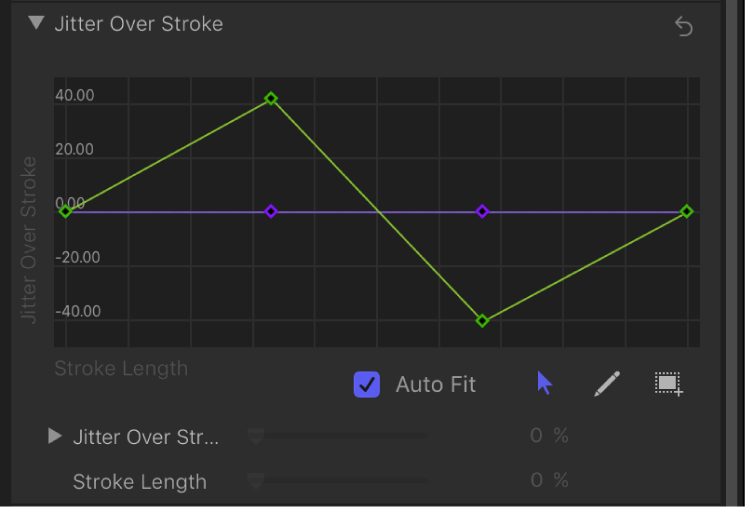
Random Seed: Controls that vary the Jitter, Brush Angle Randomness, and Brush Scale Randomness parameters (in the Stroke pane) and the Life, Speed, and Spin Randomness parameters (in the Advanced pane). If you don’t like the current random distribution of the dabs, you can change the seed number by typing a new number in the value field or clicking Generate. The Jitter value must be 1 or more for this parameter to have any effect.
Download this guide: PDF